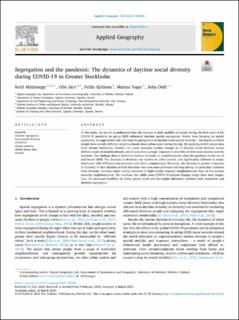Segregation and the pandemic: The dynamics of daytime social diversity during COVID-19 in Greater Stockholm
Peer reviewed, Journal article
Published version
Permanent lenke
https://hdl.handle.net/11250/3097692Utgivelsesdato
2023Metadata
Vis full innførselSamlinger
Sammendrag
In this study, we set out to understand how the changes in daily mobility of people during the first wave of the
COVID-19 pandemic in spring 2020 influenced daytime spatial segregation. Rather than focusing on spatial
separation, we approached this task from the perspective of daytime socio-spatial diversity – the degree to which
people from socially different neighbourhoods share urban space during the day. By applying mobile phone data
from Greater Stockholm, Sweden, the study examines weekly changes in 1) daytime social diversity across
different types of neighbourhoods, and 2) population groups’ exposure to diversity in their main daytime activity
locations. Our findings show a decline in daytime diversity in neighbourhoods when the pandemic broke out in
mid-March 2020. The decrease in diversity was marked in urban centres, and significantly different in neigh-
bourhoods with different socio-economic and ethnic compositions. Moreover, the decrease in people’s exposure
to diversity in their daytime activity locations was even more profound and long-lasting. In particular, isolation
from diversity increased more among residents of high-income majority neighbourhoods than of low-income
minority neighbourhoods. We conclude that while some COVID-19-induced changes might have been tempo-
rary, the increased flexibility in where people work and live might ultimately reinforce both residential and
daytime segregation.

